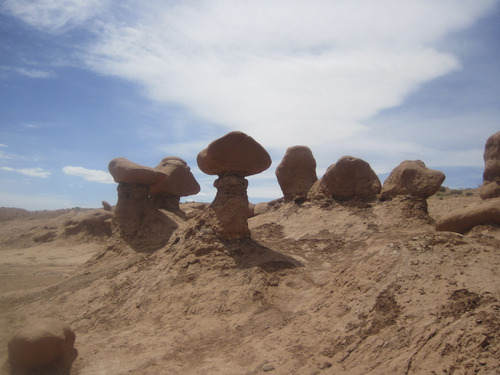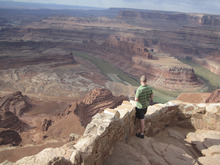This is an archived article that was published on sltrib.com in 2011, and information in the article may be outdated. It is provided only for personal research purposes and may not be reprinted.
Scenery pays. And it doesn't cost much to maintain.
Those are two reasons Dead Horse Point and Goblin Valley are among the nine Utah State Parks that make a profit and why Snow Canyon comes close each year.
"We are lucky," said Megan Blackwedler, the park manager at Dead Horse Point State Park near Moab. "We are next door to two amazing national parks. Location, location, location. That makes a big difference for us."
Indeed, most of the 175,000 visitors who visit Dead Horse Point each year also stop at Canyonlands and Arches national parks or at the Moab Information Center. When they ask about Dead Horse Point, most are encouraged to view the scenic overlook.
That is one reason the park made 131 percent of its operating budget in the 2010 fiscal year. Only Bear Lake with 133 percent gave the state a better return.
It helps that Dead Horse Point, Goblin Valley and Snow Canyon all enjoy longer seasons than other parks. Dead Horse's 21-unit campground is filled nearly every night between March and October. Goblin Valley's 24-unit facility fills from mid-March to mid-June and September and October and most summer weekends. And Snow Canyon is a place many Wasatch Front residents visit in the winter because of its mild temperatures.
It might be expected that Dead Horse Point would be a major destination because it is near Moab, where tourism is booming. The same can be said for Snow Canyon, which has almost become an urban park as nearby St. George continues to grow.
But why does Goblin Valley turn a 103 percent profit? The little park is at least a three-hour drive from the Wasatch Front and is 32 miles from the nearest town, tiny Hanksville, and farther still from Capitol Reef National Park.
"A lot of it has to do with the fact we have such low overhead," said Goblin Valley assistant park manager Sarah Siefken. "We have two full-time staffers. Scenic parks don't have the same level of maintenance as golf courses and reservoir parks. We don't have to mow the goblins."
She estimates that 50 percent of Goblin Valley's visitors come from outside Utah, including many foreign tourists. The place is especially popular with Germans because it has been featured in guidebooks and calendars.
"In the spring, we get big families from the Wasatch Front," said Siefken. "We get generation after generation. Part of the appeal is it is so kid-friendly. When you head down into the goblins, it's a big playground. Kids really like it here, which helps us out here in Utah."
On a recent Friday, Blackwelder and Siefken worked entrance stations at their parks collecting fees and greeting visitors. The parks are operated with small staffs supplemented by seasonal employees and, in the case of Dead Horse Point, interns and volunteers.
Like all state parks, Goblin Valley, Snow Canyon, Dead Horse Point and Kodachrome Basin have been required to put together business plans in recent years. The result is that gift shops and concessionaires help supplement income.
At Dead Horse Point, for example, a new concessionaire opened a coffee and sandwich shop this spring. An art gallery featuring Moab artists was opened in a vacant part of the visitor center. That increases visitation when a new show opens, and part of the proceeds from art sold goes to the park. A new mountain-biking trail also has proved to be a major draw.
"What's made Dead Horse Point so successful is they do a little retail there," said Utah State Parks Director Mary Tullius. "There is a store where they sell T-shirts with Dead Horse Point on them. The park gets so many foreign and out-of-state visitors who are willing to spend a few more bucks to buy something to take home."
Not all the scenic parks are thriving, though.
According to the legislative audit, Kodachrome Basin made up only 48 percent of its operational budget through revenue. Each visitor to that park requires a $3.59 subsidy.
Park manager Aaron Farmer, who spent 20 years working in the retail trade before managing state parks in Utah and Virginia, said the park has steadily increased its revenue since 2005. Its operational budget will decrease this year because one of its three full-time employees retired and will not be replaced. Farmer hopes a new concessionaire providing horseback rides will bring in visitors and income. Sales at the retail gift shop are also up.
That said, he thinks the $6 day-use fee and $16 camping fee should be increased.
"We wanted to go up to $7 or $8 [for day use] and raise camping fees, but the Legislature didn't want us to increase fees," he said.
Tullius said all the parks in the system have formulated business plans that are accessible to every employee.
"By sharing those ideas, you will see good things come out of that in the next two years," she said.
Twitter: @tribtomwharton —
Scenic state parks
From 2010 fiscal year
Dead Horse Point • 177,388 visitors generated $690,252 in revenue, turning a 91-cent profit for each visitor.
Goblin Valley • 46,769 visitors generated $249,096 in revenue, turning a 14-cent profit for each visitor.
Snow Canyon • 322,446 visitors generated $400,760 in revenue, losing 9 cents for each visitor.
Kodachrome Basin • 52,506 visitors generated $172,409 in revenue, losing $3.59 per each visitor.
Source: Utah Legislative Auditor General —
Economic impact of scenic parks
Dead Horse Point • In 2007, Dead Horse Point had a $7.8 million impact on state and local economies and led to the creation of up to 143 jobs. In 2009, estimates were that visitors created $4.1 million in local wages. In 2009, San Juan County received $42,240 in sales and use taxes, and $3,946 in transient room taxes from the park.
Goblin Valley • In 2009, visitors to Goblin Valley created $834,000 in local wages, earnings, rents and tax revenues within Emery County, about $76.88 per county resident.
Kodachrome Basin • Kodachrome generated $704,656 in local wages, earnings, rents and tax revenues within Garfield County in 2009. The county received $11,903 in sales and use taxes, and $6,646 in transient room taxes from Coral Pink and Kodachrome state parks.
Snow Canyon •Visitor spending could be responsible for as much as $7.6 million in local wages, earnings, rents and tax revenues in 2009, including $863,000 representing estimated taxes paid to the county by visitors.
Source: Utah State Parks Tribune series: The issues facing Utah's state parks
July 3 • Utah's 43 state parks are reeling from budget cuts, which have slashed general funding from $12.2 million to $6.8 million in recent years.
July 3 • Rock Cliff Nature Center at Jordanelle State Park closed July 1 because of budget cuts. Additionally, 23 full-time state parks positions were eliminated.
July 11 • Edge of the Cedars Museum, the largest federal depository for artifacts in the Four Corners, is holding on, despite being listed second on the Legislature's audit list of facilities under consideration for closure.
July 12 • Camp Floyd/Stagecoach Inn State Park and Museum has gone from what was essentially a restroom stop into a money-generating venture.
July 17 • The Legislature recommended eliminating law-enforcement positions in Utah State Parks. Rural law-enforcement agencies fear the changes could leave them shorthanded in times of need. Agency officials worry about public safety in the parks because of the reductions. Also, an update on ranger Brody Young, who was shot nine times during a patrol in 2010.
July 19 • Utah owns five golf courses managed by state parks. One, Wasatch Mountain, makes money, but the rest lose money — and Green River is in danger of closing.
July 25 • Budget cuts hit small staffs managing urban playground parks especially hard; rangers are left trying to juggle ensuring visitor safety with park maintenance duties.
July 26 • Rounds of golf played at Soldier Hollow and Wasatch Mountain's camping, hiking, off-highway vehicle riding, cross-country skiing, fishing, picnicking and snowmobiling make Wasatch Mountain the most-visited park in the state, with more than 360,000 visitors a year.
Aug. 2 • The gem of the state parks system very well may be Antelope Island. With its diverse wildlife and great views, it attracts nature lovers from all around the world.
Aug. 2 • Small rural water recreation parks such as Huntington, Hyrum and Steinaker are among eight rural Utah State Parks that require close to a million dollars in taxpayer dollars each year. Are they worth it?
Aug. 9 • To many, closing or handing off management of some state parks is the most obvious answer to the state parks' budget woes. It has been done before, but with mixed results.
Aug. 9 • Although it wouldn't be economically beneficial to put in more facilities at largely primitive areas, so-called forgotten parks have intrinsic value to the state.
Aug. 22 • A private foundation has taken over This Is the Place State Park but still needs a large state subsidy to stay in business.
Aug. 22 • Park concessionaires and campground hosts help provide services that might otherwise be missing from Utah State Parks.
Aug. 23 • Otter Creek and Anasazi state parks might be small and off the beaten tourist track, but both mean a great deal to their small communities.
Aug. 30 • Scenic state parks provide some of Utah's most iconic sights and, in some cases, turn a per-visitor profit.







